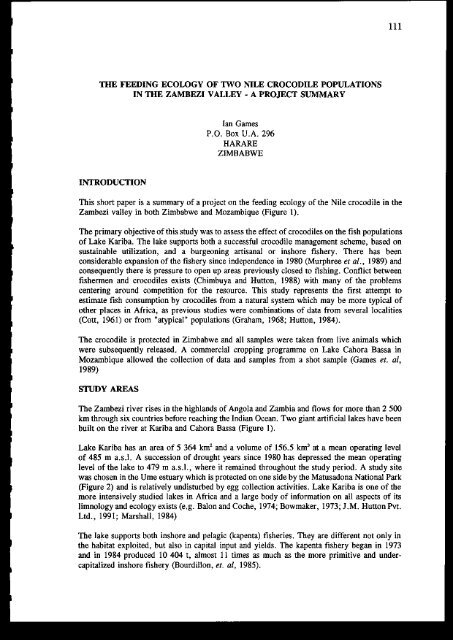size: 5036KB - Crocodile Specialist Group
size: 5036KB - Crocodile Specialist Group
size: 5036KB - Crocodile Specialist Group
You also want an ePaper? Increase the reach of your titles
YUMPU automatically turns print PDFs into web optimized ePapers that Google loves.
111<br />
THE FEEDINC ECOLOGY OF TWO NILE CROCODILE FOPIJLATIONS<br />
IN THE ZAMBEZI VALLEY - A PROJECT SUMMARY<br />
Ian Games<br />
P.O. Box U.A. 296<br />
HARARE<br />
ZIMBABWE<br />
INTRODUCTION<br />
This short paper is a summary of a p{oject on $e feeding ecology ofthe Nile crocodile in the<br />
Zambezi valley in both Zimbabwe and Mozambique (Figure 1).<br />
The primary objective of this study was to assess the effect of crocodiles on the fish populations<br />
of Lake Kdiba. The lake supports boft a successful crocodile management scheme, based on<br />
sustainable utilization, and a burgeoning a.tisanal or inshore fishery. There has been<br />
considerablexpansion of the fishery since independence<br />
1980 (Murphree et al. , I 989) and<br />
consequently there is pressure to open up areas prcviously closed to fishing. Conflict between<br />
fishermen ard crocodiles exists (Chimbuya and Hutton, 1988) with many of the problems<br />
centering around competition for the resource. This study represents fte first aftempt to<br />
estimate fish consumption by crocodiles {iom a natural system which may be more typical of<br />
other places in Africa, as previous studies were combinations of data from several localities<br />
(Cott, 1961) or from "atypical" populations (Graham, 1968; Hufton, 1984).<br />
The crocodile is protected in Zimbabwe and all sample,s were taken from live animals which<br />
were subsequently released. A commercial cropping progranme on Lake Cahora Bassa in<br />
Mozambique allowed the collection of data and samples from a shot sample (Games et. al,<br />
1989)<br />
STIJDY AREAS<br />
The Zambezi river rises in the highlands ofAngola and Zambia and flows for more than 2 500<br />
km through six countries before reaching the Indian Ocean. Two giant artificial lakes have been<br />
built on the river at Kariba and Calora Bassa (Figure 1).<br />
Lake Kariba has an area of 5 364 km2 and a volume of 156.5 km3 at a mean operating level<br />
of 485 m a.s.l. A succession of drought yea6 since 1980 has depressed the mean openting<br />
level of the lake to 479 m a.s.l., where it remained throughout the study period. A study site<br />
was chosen in the Ume estuary which is protected on one sideby the Matusadona National Park<br />
(Figure 2) and is relatively undisturbed by egg collection activities. Lake Kariba is one ol the<br />
more intensively studied lakes in Afiica and a large body of information on all aspects of its<br />
limnology and ecology exists (e,g. Balon and Coche, 1974; Bowmaker, 1973; J.M. Hutton Pvt.<br />
lsd., 1991, Marshall, 1984)<br />
The lake supports both inshore and pelagic (kapenta) fisheries. They are different not only in<br />
the habitat exploited, but also in capital input and yields. The kapenta fishery began in 1973<br />
and in 1984 produced 10404 t, almost 1l times as much as the more primitive and undercapitalized<br />
inshore fishery (Bourdillon, ?t. dl, 1985).
















